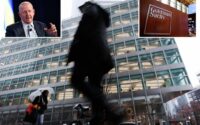Amtrak poised to lose monopoly as Brightline bullet trains unveiled
President Joe Biden’s favorite mode of transportation, Amtrak, is about to lose its monopoly in some parts of the country.
Brightline, the nation’s only privately owned train company, will introduce high-speed service from Miami to Orlando in the coming weeks that will cut the commute in half.
The Brightline Florida link between the two cities, which cost $6 billion to build, will reach speeds of more than 125 mph in some areas — the fastest train outside of the Acela-service Northeast corridor stretching from Washington, DC, and Boston.
The 170-mile rail link will run 16 daily round trips between downtown Miami and Orlando International Airport beginning later this year. Tickets start at $79 and go up to $149 for first-class seats.
Amtrak currently offers two daily train trips between Miami and Orlando — ranging in price between $39 and $49 — that usually takes six hours and 19 minutes. A faster Amtrak Silver Service train can make the trip in just over five hours.
Brightline first began operations five years ago, when it launched a 67-mile Miami-to-West Palm Beach route — the first privately funded passenger rail built in the US in more than a century.
The company also has plans to eventually connect Orlando with Tampa.
Fortress Investment Group, a private equity firm co-founded by billionaire Milwaukee Bucks owner Wes Edens and Randal Nardone, owns the Brightline service.

Edens told The Washington Post that Florida’s intercity expansion will serve as a kind of blueprint for the company’s ambitions to replicate similar rail-building out West.
Rail construction for a rapid train route connecting Los Angeles and Las Vegas is scheduled to begin later this year after the federal funding for the $12 billion project, known as Brightline West, was given approval by regulators. The funding was part of the $66 billion allocated for rail in the $1 trillion infrastructure deal signed by Biden in 2021.
The all-electric bullet train will ferry passengers along the 218-mile route at a speeds of almost 200 mph — completing the trip from Las Vegas to Rancho Cucamonga in two hours and 10 minutes.

The line, which is scheduled to begin service in late 2027 or early 2028, will include stops at Hesperia, Calif., and Victor Valley, Calif.
“Florida is Version 1.0, and we think it’s a great 1.0,” Edens told The Washington Post.
“Version 2.0, the high-speed rail from Vegas to L.A., we think is the real embodiment of what high-speed rail can and should look like,” Edens said.
“And that’s the system that people will look at and emulate when they look at building systems around the country.”

Brightline’s Florida service has had its share of hiccups.
At least 88 people have died due to collisions with Brightline trains since it started operating in 2017, though none of the deaths were blamed on the company.
Investigators said the deaths could be attributed to either suicides or pedestrians and drivers violating traffic laws by circumventing crossing barriers in an attempt to beat the oncoming train rather than wait for it to pass.

The trains travel up to 79 mph through densely populated urban and suburban areas along 70 miles of track between Miami and West Palm Beach that it shares with the Florida East Coast freight line.
An AP analysis found that Brightline averages about one death for every 35,000 miles its trains travel, three times worse than the next mid-size or major railroad.
In response to the accidents, Brightline has installed infrared detectors to warn engineers if anyone is lurking near the tracks so they can slow down or stop.
The company also has added more fencing and landscaping to make track access more difficult.
The Post has sought comment from Amtrak.
With Post Wires


